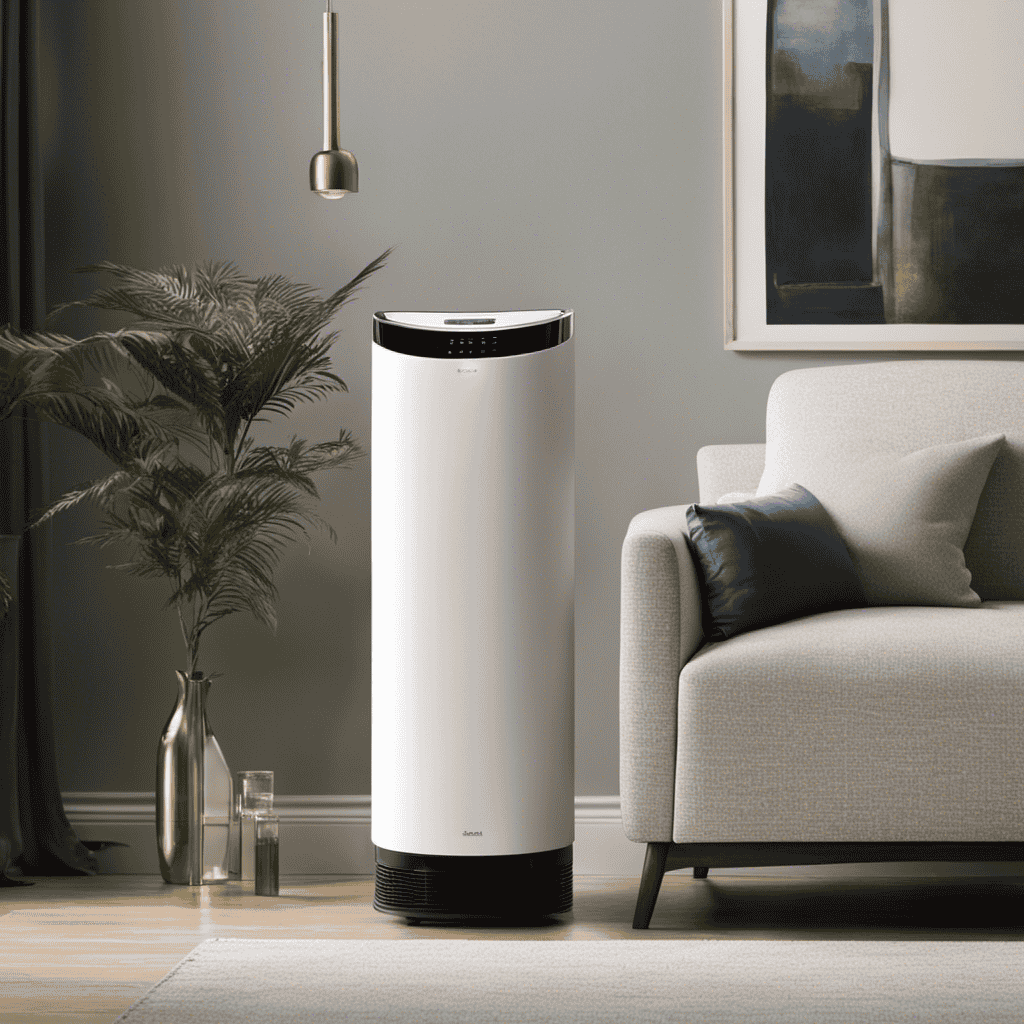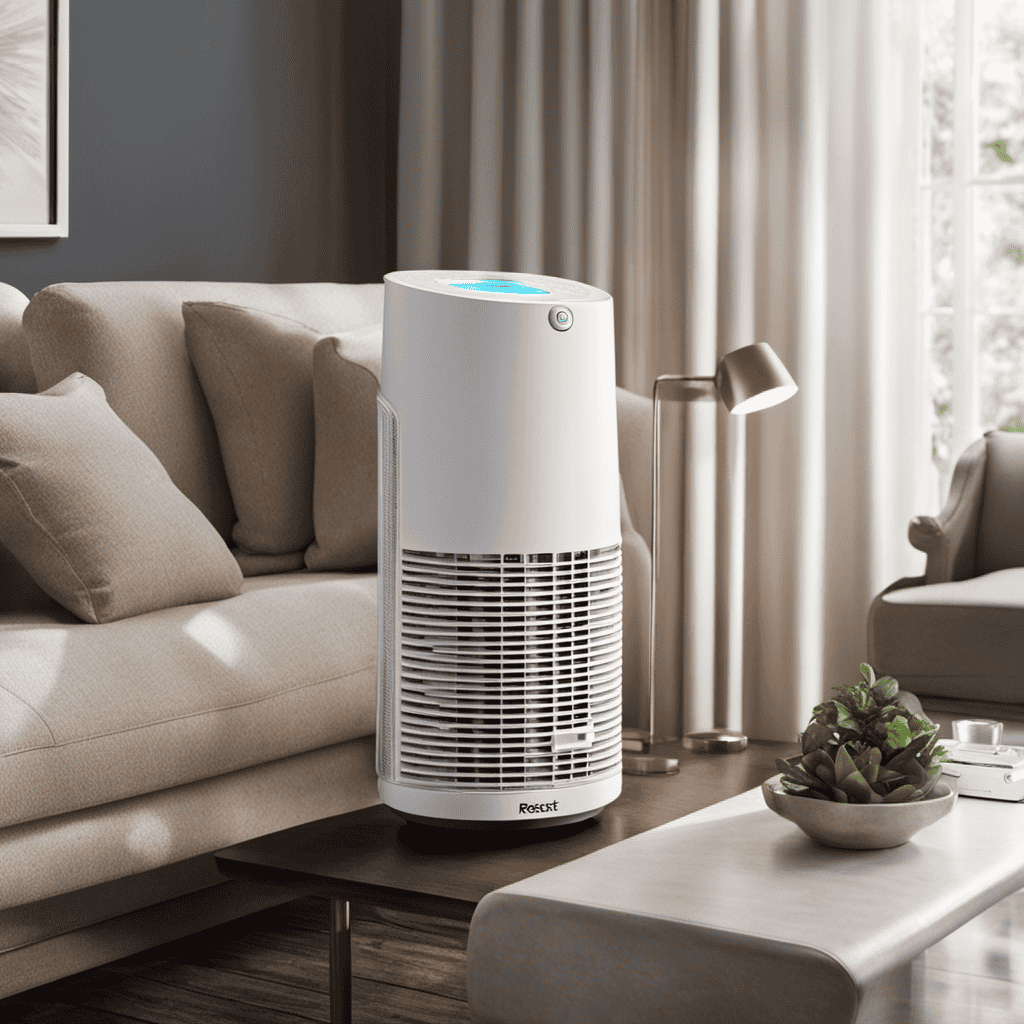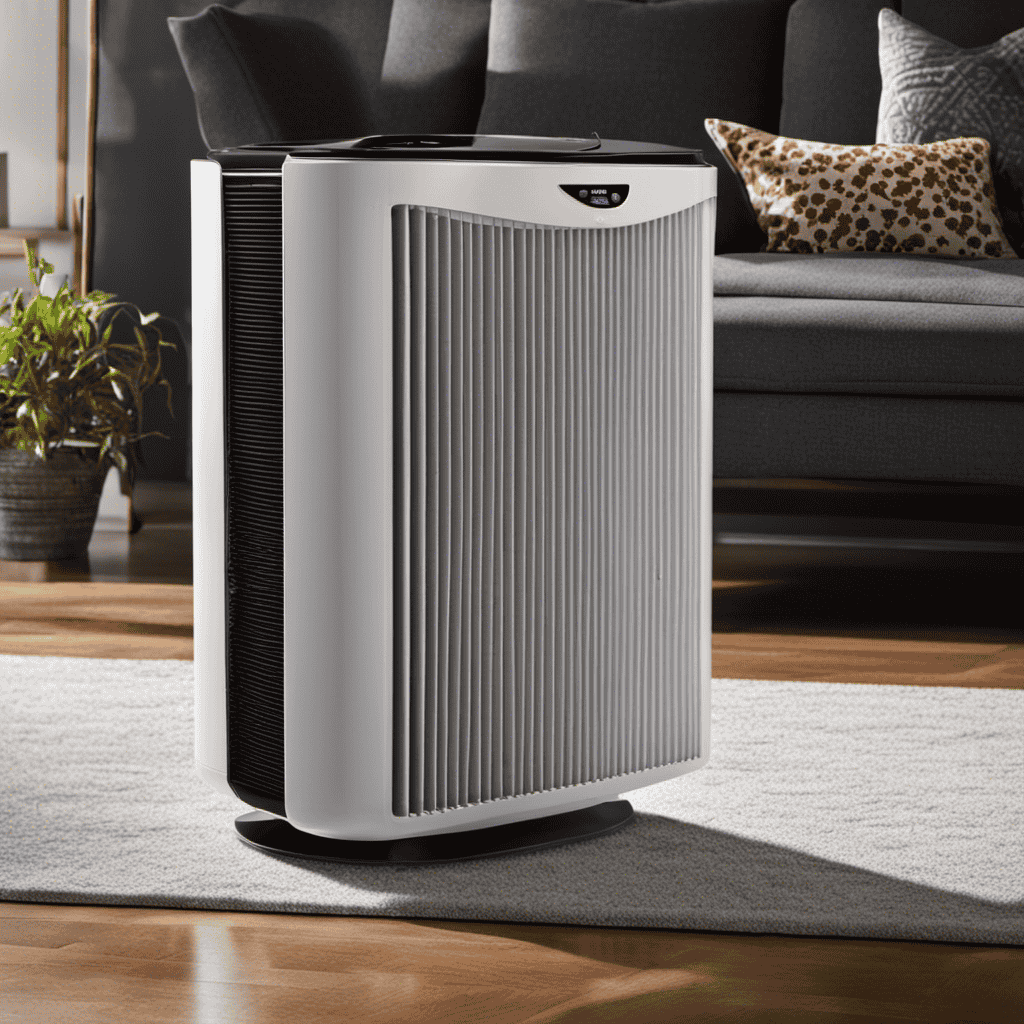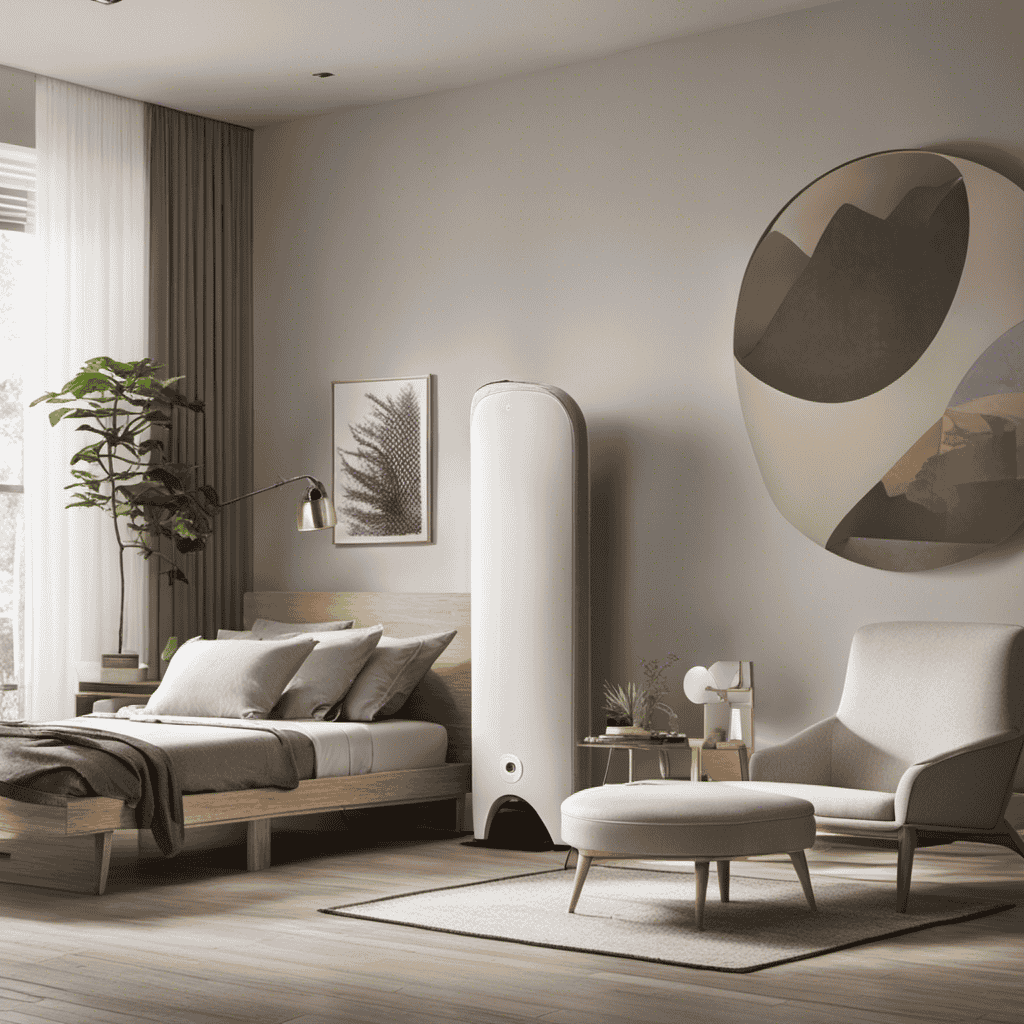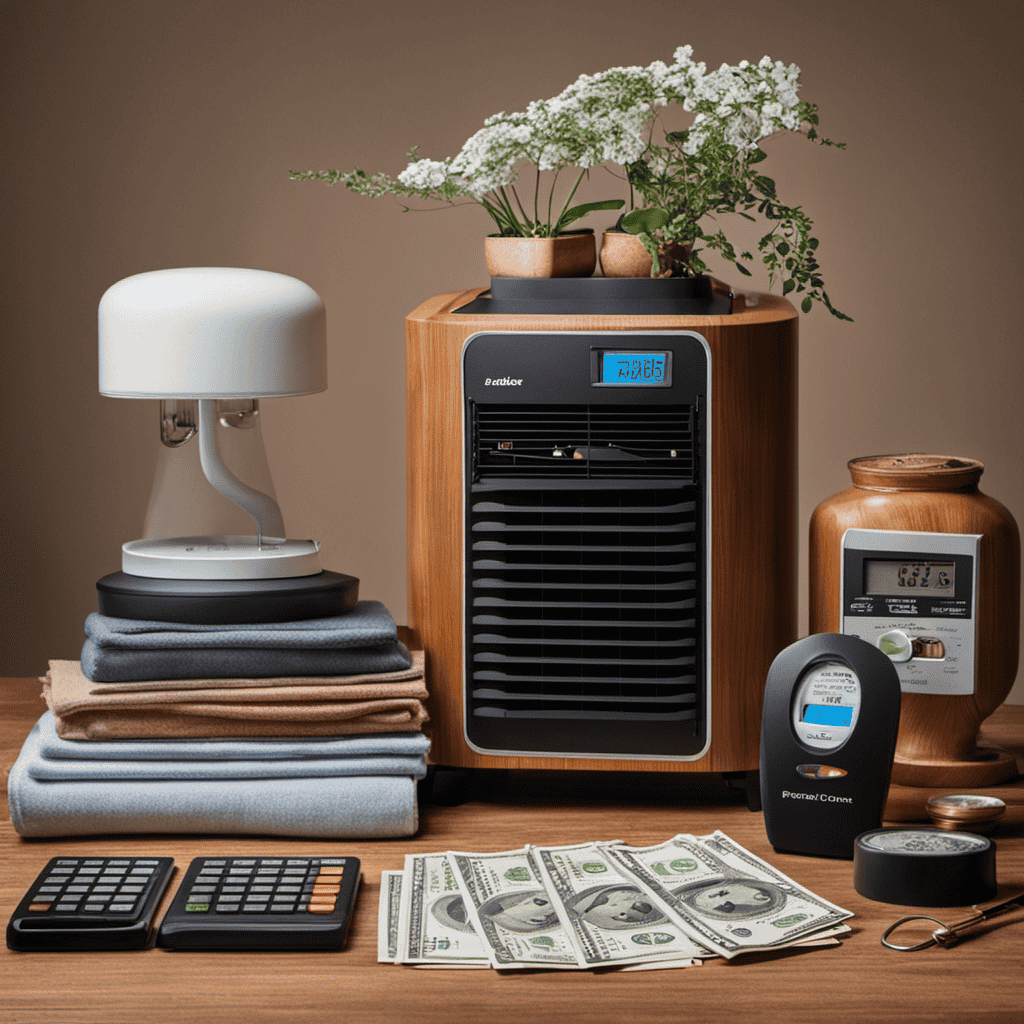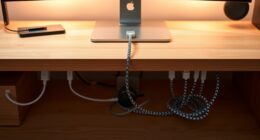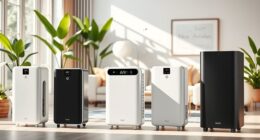I have always been curious about how air purifiers work, as I am passionate about researching and promoting clean air.
It’s fascinating to think about how this small device can effectively clean the air we breathe every day.
In this article, we’ll delve into the basics of air purification and explore the intricate mechanisms that enable air purifiers to trap and eliminate airborne pollutants.
From filters to UV-C light and activated carbon, we’ll uncover the scientific principles behind these devices and learn how to choose the right air purifier for our specific needs.
Key Takeaways
- Airborne pollutants such as particulate matter and gaseous pollutants can cause respiratory issues and other health problems.
- HEPA filters and electrostatic precipitators are effective in removing airborne particles as small as 0.3 microns, with HEPA filters able to remove up to 99.97% of particles.
- Regular maintenance and cleaning are necessary for optimal performance of both HEPA filters and electrostatic precipitators.
- Air purifiers improve air circulation, remove contaminants, reduce odors, and can have significant benefits for indoor air quality and overall health and well-being.
The Basics of Air Purification
An air purifier uses filters to trap and remove harmful particles from the air. Understanding air pollutants is crucial to realizing the benefits of air purification.
Air pollutants can be categorized into two main types: particulate matter and gaseous pollutants. Particulate matter includes dust, pollen, pet dander, and smoke particles. Gaseous pollutants, on the other hand, include volatile organic compounds (VOCs), chemical fumes, and odors. These pollutants can cause respiratory issues, allergies, and other health problems.
Understanding Airborne Pollutants
To understand airborne pollutants, you need to be aware of the various particles and contaminants that can float in the air. These airborne contaminants come from a variety of sources, including industrial emissions, vehicle exhaust, and even natural sources like pollen and dust. It’s important to recognize these sources in order to effectively mitigate air pollution and protect our health.
| Airborne Contaminants | Sources | Effects |
|---|---|---|
| Particulate matter | Industrial emissions | Respiratory problems, reduced visibility, cardiovascular disorders |
| Volatile organic compounds (VOCs) | Vehicle exhaust, paints, solvents | Eye, nose, and throat irritation, headaches, nausea |
| Pollen and allergens | Plants, trees, flowers | Allergic reactions, asthma attacks, respiratory discomfort |
How Air Purifiers Trap Particles
When it comes to air purifiers, understanding the different types of filters is crucial. In this discussion, I will explain the various filter types and their effectiveness in removing particles from the air.
Additionally, we will explore the benefits of improved air circulation that air purifiers provide, ensuring a healthier and cleaner indoor environment.
Filter Types Explained
There are different filter types used in air purifiers to clean the air. One popular type is the HEPA (High Efficiency Particulate Air) filter. HEPA filters are highly efficient at trapping small particles such as dust, pollen, and pet dander. They can remove up to 99.97% of airborne particles as small as 0.3 microns. This makes them ideal for individuals with allergies or asthma.
Another filter technology commonly used is electrostatic precipitator. This type of filter uses an electric charge to attract and trap particles. As air passes through the filter, the charged particles stick to the oppositely charged plates, effectively removing them from the air. Electrostatic precipitators can also capture volatile organic compounds (VOCs) and other pollutants.
Both HEPA filters and electrostatic precipitators play a crucial role in improving indoor air quality and creating a healthier living environment.
Effective Particle Removal
HEPA filters and electrostatic precipitators are both highly efficient at trapping and removing small particles from the air. These devices play a crucial role in improving indoor air quality and protecting respiratory health.
Here are five key points about their effectiveness in removing indoor pollutants:
-
HEPA filters and electrostatic precipitators can capture particles as small as 0.3 micrometers, including dust, pollen, pet dander, and mold spores.
-
These filters work by creating a physical barrier or using an electric charge to attract and trap particles, preventing them from recirculating in the air.
-
HEPA filters can remove up to 99.97% of airborne particles, while electrostatic precipitators can achieve an efficiency of over 95%.
-
Both types of filters require regular maintenance and cleaning to ensure optimal performance.
-
By reducing exposure to indoor pollutants, HEPA filters and electrostatic precipitators can help alleviate symptoms of respiratory conditions such as asthma and allergies.
Air Circulation Benefits
One of the benefits of using HEPA filters and electrostatic precipitators is that they improve the circulation of fresh, clean air in indoor spaces. These air purification methods work by capturing and removing harmful particles and pollutants from the air, allowing for a healthier environment. By removing allergens, dust, smoke, and other contaminants, air purifiers create a cleaner atmosphere that is beneficial for everyone, especially those with respiratory conditions or allergies. Additionally, air purifiers help to reduce odors, making the indoor air more pleasant and inviting. The improved circulation of clean air provided by these purifiers can lead to better overall health and well-being. So, whether you’re at home, in the office, or in a public space, investing in an air purifier can have significant benefits for your indoor air quality.
| Air Purification Methods | Benefits of Air Purifiers |
|---|---|
| HEPA Filters | Captures allergens and pollutants effectively |
| Electrostatic Precipitators | Removes fine particles and improves air quality |
| Removes odors | Creates a pleasant and fresh indoor environment |
The Role of Filters in Air Purifiers
When it comes to air purifiers, understanding the effectiveness of filters is crucial.
In this discussion, I will explain how filters work to trap particles and improve air quality.
Additionally, we will explore the different types of filter options available in air purifiers and their specific functions.
Filter Effectiveness Explained
The filter in an air purifier is designed to trap and remove particles from the air, making it cleaner and healthier to breathe. To ensure the optimal functioning of the filter, regular maintenance is essential. Here are some key points about filter maintenance and air purifier technology:
-
Replace Filters: Filters should be replaced according to the manufacturer’s recommendations to ensure efficiency.
-
Cleaning: Some filters can be cleaned, but it’s important to follow the instructions carefully to avoid damage.
-
Filter Lifespan: The lifespan of a filter depends on various factors like usage, air quality, and filter type.
-
Pre-Filters: Many air purifiers have pre-filters that capture large particles, extending the life of the main filter.
-
HEPA Filters: High-Efficiency Particulate Air (HEPA) filters are widely used as they can capture particles as small as 0.3 microns, including allergens, dust, and smoke.
Understanding filter maintenance and the technology behind air purifiers can help ensure cleaner air and a healthier living environment.
Types of Filter Options
HEPA filters are commonly used due to their ability to capture particles as small as 0.3 microns. These filters work by using a dense mesh of fibers that trap airborne particles as air passes through.
However, there are other filter options available as well. One such option is electrostatic filters. These filters use an electric charge to attract and capture particles. The charged filter media acts like a magnet, pulling in particles of all sizes. This makes electrostatic filters highly effective in removing not only dust and pollen, but also smaller particles like bacteria and viruses.
Additionally, electrostatic filters can be washed and reused, making them more cost-effective in the long run. However, it’s important to note that electrostatic filters may produce ozone as a byproduct, which can be harmful in high concentrations. Therefore, it is crucial to choose an electrostatic filter that meets industry standards for ozone emissions.
The Power of UV-C Light in Air Purification
Using UV-C light in your air purifier helps to eliminate harmful bacteria and viruses from the air you breathe. The effectiveness of UV-C light in air purification is well-documented and widely recognized in the scientific community.
Here are some key applications and benefits of UV-C light in air purification:
-
Sterilization: UV-C light has the ability to destroy the DNA and RNA of microorganisms, rendering them unable to reproduce and causing their death.
-
Disinfection: UV-C light can effectively eliminate a wide range of pathogens, including bacteria, viruses, and molds.
-
Chemical-free: Unlike chemical disinfectants, UV-C light does not leave behind any harmful residue or produce any harmful byproducts.
-
Continuous operation: UV-C light can operate continuously, ensuring that the air in your space is constantly being treated and purified.
-
Enhanced air quality: By eliminating harmful microorganisms, UV-C light helps improve the overall air quality, reducing the risk of respiratory infections and allergies.
Incorporating UV-C light into your air purification system provides a powerful and effective method for keeping the air you breathe clean and healthy.
Ionizers and Air Purification
Did you know that ionizers can greatly improve the efficiency of your air purification system?
Ionizers are a key component of many modern air purifiers, utilizing ionizer technology to enhance the overall air cleaning process. These devices work by emitting negative ions into the air, which attach themselves to airborne particles such as dust, pollen, and smoke.
Once attached, these particles become heavier and eventually fall to the ground or are easily captured by the air purifier’s filters. The negative ions also help to neutralize harmful pathogens and allergens, making the air cleaner and safer to breathe.
Ionizer technology is particularly effective in removing smaller particles that may escape traditional air filters, ensuring a more thorough purification process.
The Importance of Activated Carbon in Air Purifiers
In the previous subtopic, I discussed ionizers and their role in air purification. Now, let’s delve into the importance of activated carbon in air purifiers.
Activated carbon is a highly porous material that effectively traps and removes various airborne contaminants. Here are some benefits of using activated carbon in air purifiers:
-
Adsorption: Activated carbon has a large surface area that attracts and binds pollutants, such as gases, chemicals, and volatile organic compounds (VOCs).
-
Odor elimination: The adsorption properties of activated carbon help to neutralize unpleasant smells, making the air fresher and more pleasant.
-
Chemical filtration: It can effectively remove harmful chemicals like formaldehyde and benzene from the air.
-
Allergen reduction: Activated carbon can also capture allergens like pet dander and pollen, improving indoor air quality for allergy sufferers.
-
Prolonged filter life: The use of activated carbon in air purifiers can extend the lifespan of other filters by trapping larger particles before they reach the HEPA filter.
Now, let’s explore another important aspect of air purification: ozone generators and their role in removing pollutants from the air.
Ozone Generators and Air Purification
Have you ever considered the benefits of utilizing ozone generators for improving indoor air quality?
Ozone generators have been a topic of controversy in the field of air purification. These devices work by emitting ozone, a gas that can react with pollutants and neutralize them. However, there are concerns about the potential health risks associated with ozone exposure.
To address these concerns, manufacturers have developed ozone-free air purifiers, which use alternative technologies to clean the air without producing ozone. These ozone-free air purifiers employ methods such as HEPA filtration, activated carbon, and UV-C light to remove particles, gases, and microorganisms from the air. These advanced technologies ensure effective air purification without the potential risks of ozone exposure.
Now let’s compare these air purifiers with ventilation systems to understand their respective advantages and disadvantages.
Air Purifiers Vs. Ventilation Systems
Now let’s compare how air purifiers and ventilation systems differ in terms of their advantages and disadvantages.
- Air purifiers are designed to filter and purify the air, removing pollutants and allergens.
- Ventilation systems, on the other hand, simply circulate the air in a space, without actively removing pollutants.
Air purifiers are highly effective in closed spaces, where open windows are not an option. They can eliminate harmful particles such as dust, pollen, pet dander, and even viruses and bacteria.
Ventilation systems, although they can bring in fresh air, do not have the same level of filtration capabilities as air purifiers.
In conclusion, while ventilation systems provide fresh air, air purifiers offer the added benefit of actively purifying the air. This makes them particularly beneficial in closed spaces where open windows are not possible or ideal.
Now, let’s move on to the next section and discuss how to choose the right air purifier for your needs.
Choosing the Right Air Purifier for Your Needs
To choose the right air purifier for your needs, consider factors such as room size, filtration efficiency, and noise level.
When comparing different air purifier models, it is important to understand how these factors can affect the performance and effectiveness of the device.
Room size is an important consideration because air purifiers are designed to clean a certain volume of air within a given time frame. Choosing a purifier that is too small for your room may result in inefficient air cleaning.
Filtration efficiency refers to the ability of the purifier to remove particles and pollutants from the air. Look for purifiers with high-quality filters that can capture a wide range of contaminants.
Noise level is also crucial, especially if you plan to use the purifier in a bedroom or office space. Some models may produce loud noise, which can be disruptive to your daily activities.
Frequently Asked Questions
How Often Do I Need to Replace the Filters in an Air Purifier?
I replace air purifier filters every 3 months. The cost of filters varies depending on the brand and model. Regular filter replacement ensures optimal air cleaning performance and helps maintain a healthy indoor environment.
Can Air Purifiers Remove All Types of Odors From the Air?
Yes, air purifiers can effectively remove various types of odors from the air. They work by capturing and trapping odor-causing particles, improving indoor air quality and creating a fresher environment.
Do Air Purifiers Eliminate Bacteria and Viruses in the Air?
Yes, air purifiers can eliminate bacteria and viruses in the air. Their effectiveness in eliminating pathogens depends on the type of filter used. HEPA filters are highly efficient in capturing small particles, including microorganisms.
Can an Air Purifier Help With Allergies and Asthma?
Yes, an air purifier can help with allergies and asthma by filtering and removing allergens, such as dust, pollen, and pet dander, from the air. This improves air quality and reduces triggers for respiratory symptoms.
Are There Any Safety Concerns Associated With Using an Air Purifier?
There can be potential health risks associated with using an air purifier, so it’s important to understand the proper air purifier maintenance and follow safety guidelines to minimize any potential issues.
What are the similarities and differences between Bionaire Air Purifier and other types of air purifiers in terms of cleaning the air?
When comparing the working mechanism of Bionaire air purifier with other types of air purifiers, the similarities lie in their use of filters to capture airborne particles. However, the differences can be found in the specific technologies used and the size of the particles they are capable of capturing.
Conclusion
In conclusion, air purifiers are essential in maintaining clean and healthy indoor air. They effectively trap and remove airborne pollutants using filters, UV-C light, and activated carbon.
By eliminating particles, allergens, and odors, air purifiers create a more comfortable and safe living environment.
While ventilation systems provide some level of air exchange, they cannot match the thoroughness and efficiency of air purifiers.
Therefore, when choosing the right air purifier for your needs, consider the specific pollutants you want to target and select a model that meets those requirements.
